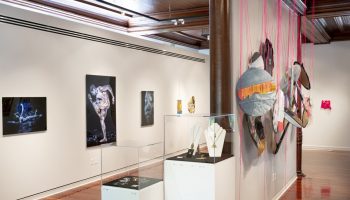Melissa Meyer was in her visiting artist’s studio at the School of Art, cutting up her squiggly abstract watercolors. She wasn’t planning rampant destruction — the paintings in their original form weren’t inspiring her, so she tried reassembling the pieces, testing their contrast against paper of different colors.
“I’m always trying to come up with something new,” she said.
Coming up with something new has been Meyer’s task for about 50 years. In her lecture at 7 p.m. Friday in the Hultquist Center, she’ll discuss her extensive career and show examples of her work, as well as images of the places that have inspired her.
“I have a favorite quote of Willem de Kooning, which is: ‘I change to stay the same,’ ” she said. “There’s a thread that you can see in my work from the beginning.”
She said the work she did in high school leads all the way through to the work she did two weeks ago.
“There’s so much change involved, and yet it’s still mine,” she said.
Meyer has been showing work since the early 1970s. She’s done public art installations in countries around the world and taught at several universities, all while continuing with her own work, which has been displayed in dozens of group and solo exhibitions over the years. In 1978, early in her career, she co-authored the influential essay “Waste Not Want Not: An Inquiry into What Women Saved and Assembled–FEMMAGE” with Miriam Schapiro, exploring practices that women have done for centuries, like quilting and scrapbooking, as art forms.
Meyer said she considers herself a feminist, but her artwork isn’t necessarily political.
“When I go to my studio, I don’t look around and say, ‘I’m going to make some feminist art!’ That’s not my thing,” she said.
Her painting process depends on the size and medium of the work, but she often paints on the floor, a habit born out of a 2002 mural project she did for the Shiodome City Center in Tokyo. The mural was so large she worked around it from every side, and that became a habit that stuck. Her experimentation with watercolors also influenced her process — instead of lightening the oils with white paint, she tried thinning them as she would watercolors, and the lower viscosity of the oils forced her to work on the ground to avoid drips.
Meyer has traveled nationally and internationally, but a few places stand out in her memory. One is Yaddo, an artists’ retreat in Saratoga Springs that she first visited in 1974, and has returned to many times since. Another is Rome; in 1980 she won the Rome Prize Fellowship and spent a year in Italy.
“I like to travel,” she said. “But I like to come home, too.”
Home for Meyer, who grew up in Queens and now lives in Chelsea, is New York City. Her friends are in the city, there’s always something to see and, like many fellow New Yorkers, she doesn’t know how to drive.
Just as the places she’s been have influenced her, Meyer has taken inspiration from other artists.
As a student, Meyer began by making figurative works, before she realized that many of the artists she liked, such as de Kooning, Joan Mitchell and Philip Guston, were abstract expressionists.
Now Meyer calls Henri Matisse one of her favorites. She recently saw a show at the Museum of Fine Arts in Boston, “Matisse in the Studio,” which displayed several works alongside objects from his studio that appeared in his paintings.
“It was beautiful,” she said. “I love his work, and I think about how when he was an invalid, and ailing, he made the most glorious work — these large collages — and you have no sense of this man being in pain. It’s all positive and joyful.”
Of course, interpreting paintings presents a challenge.
“It’s not a verbal language,” she said. “I think people have to trust their responses and look at it. And I don’t like to tell people how to look at it.”
She does have ideas about the purpose of painting, however.
“Depends on the painting, but I think some kind of pleasure or joy,” she said.
She thinks of paintings as spiritual, although not in a religious sense.
“The origin of the word comes from the Greek ‘spiritus,’ which means ‘the breath,’ ” she said. “And without breath, there’s no life.”




